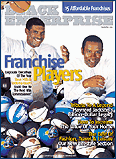Here's how to start a specialty cart for under $10k
By Marcia Layton TurnerBlack Enterprise
Shoppers spend nearly $10 billion each year on retail products sold from carts and kiosks in malls, subway stations, and upscale resorts, according to Specialty Retail Report (www.specialtyreport.com), the industry's magazine. Although small in size, carts and kiosks are popular for many reasons, including high profit margins, low startup costs, and the option of working only a few months a year.
Patricia Norins, author of the Ultimate Guide to Specialty Retail: How to start a cart, kiosk, or store (Specialty Retail Report; $49), and publisher of Specialty Retail Report, offers advice for getting started:
Products You Love. "Select a product you like, even love," says Norins.
Also, select a unifying theme, Norins advises, specializing in one product or category rather than trying to sell a little bit of everything.
Getting Started. Contact the specialty leasing agent at the mall where you want to locate your cart/kiosk. They are generally reachable through the mall manager's or owner's office. Since some malls charge a base rent plus a percentage of sales, new businesses that can demonstrate major revenue potential have an edge in landing temporary space. Prepare a business plan or proposal to wow the leasing agent, describing your products or theme, why you expect your cart to do well in that particular location, any innovative selling or marketing strategies you'll use, and your anticipated annual sales. Also, find out if your city or town requires cart and kiosk owners to have a retailer's license or permit.
There are cart/kiosk designers and manufacturers that supply malls and shopping centers with units, but you don't need to buy one to get started. Almost all malls with cart programs provide them as part of the lease cost -- that way the mall can control the size and appearance of the carts and ensure consistency.
Setting Up Shop. Howard Brown, owner and president of Ho-B'z Hats Inc., knew visibility for his kiosk was critical to his success, so he secured a spot just beyond the high-traffic food court at the Jefferson Mall in Louisville, Kentucky. Brown's personalized baseball caps were eye-catching, but he also wanted customers to see his high-speed embroidery equipment. On a typical day, Brown embroiders 20 to 30 items -- caps, shirts, and bags, for example, for $21 and up.
Monthly lease rates for carts or kiosks can range from $800 to $3,000 in the off-season, which is January through October, says Norins. Those costs rise significantly during the holiday season due to holiday foot traffic, but with month-to-month leases standard, there is little up-front investment or commitment.
Hire Some Help. Temporary retailers are required to be open the same hours as the mall, which generally means more than 40 hours a week. Hiring four to five part-time employees at the start can help ease the strain, says Norins. However, some operators work only during the holiday months of November and December, when they generate 80% of their annual revenue.
While there is no guarantee of success, cart and kiosk owners who find the right product for their market are rewarded with sales as high as $12,000 a month or more during the busy holiday season. Not bad for a space-challenged business.
http://www.blackenterprise.com
![]() Email Article
Email Article
![]() Print Article
Print Article




